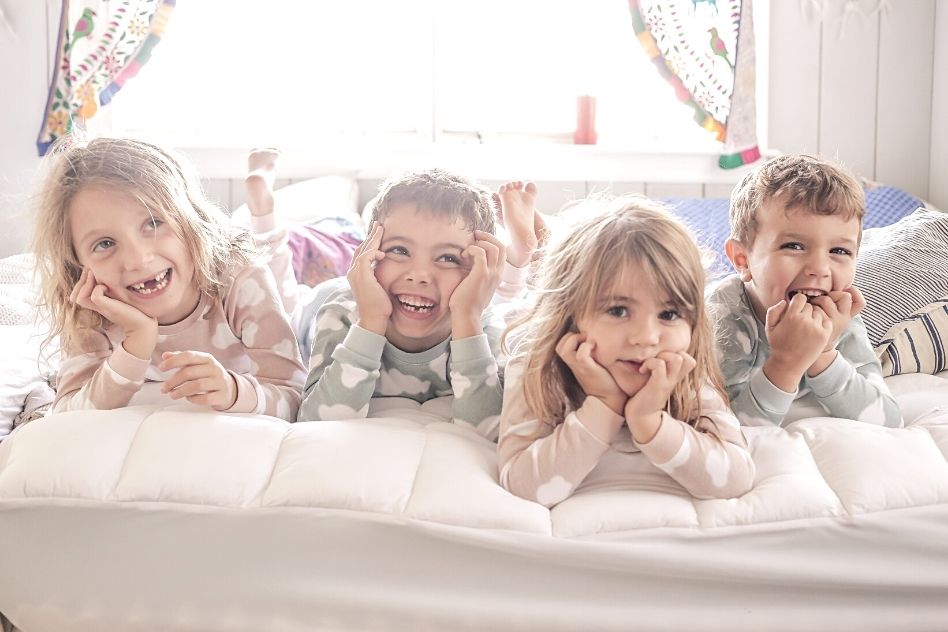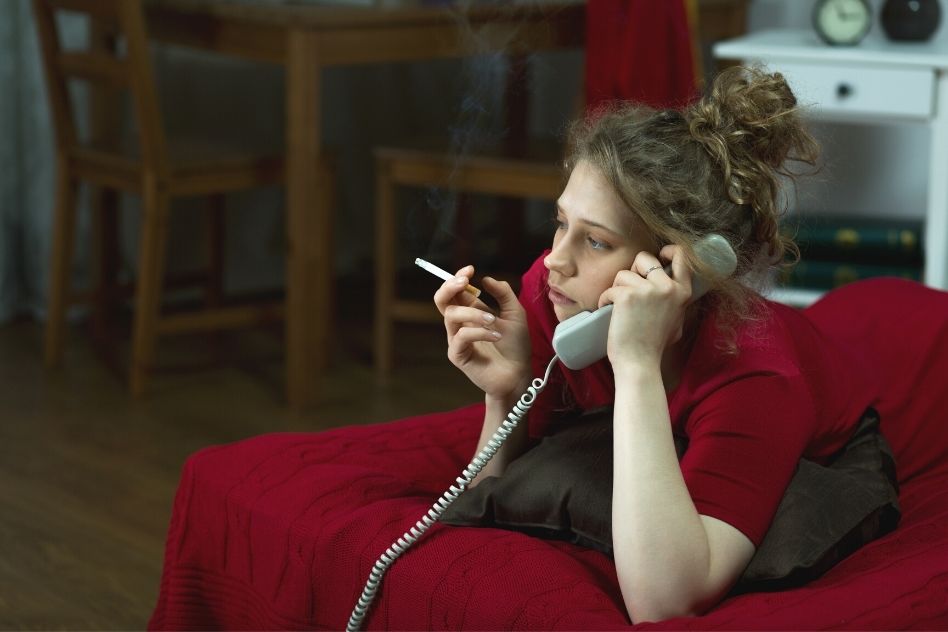Does Us Require Flame Retardants on Baby Blankets
If you store at Carter'south or Target for kids clothes you probably never knew about the laws concerning flame resistant laws for toddler clothing in the The states (I'll explain why is that in the commodity). Information technology wasn't until I started ownership organic toddler clothing and bamboo that I was all of a sudden bombarded with bright yellow tags stating:
"For kid's safety, garment should fit snugly. This garment is not flame resistant. Loose-plumbing fixtures garment is more probable to catch burn down."
The label pictured in a higher place is big and bright and seems a little alarming, only it'due south the law for children's sleepwear.
Before y'all freak out and get downwards into the rabbit pigsty of wondering whether your baby or toddler is prophylactic, let me tell you lot that the law is pretty outdated and there's a long story behind it. These yellow tags really hateful that the clothes are practiced for your kid and you should exist looking for them
As my first son spent his early on toddlerhood in Europe I've never encountered these tags before we moved back. Why? Because this constabulary is unique to the Us (and parts of Canada), doesn't exist anywhere else.
Information technology's called Flammable Fabrics Act and it's actually very questionable. I really didn't expect it to be so bad, just while researching materials for this article I kept finding more than and more things that made me question basically every single baby items – whether crib, car seat or clothing sold in the US.

Why practice infant clothes need to be flame retardant?
What is the purpose of the children'south sleepwear flammability standards? Officially, it's to protect children from burns, these rules require that children's sleepwear must be flame resistant and self-extinguish if a flame from a candle, match, lighter, or a similar item causes it to catch burn. The rules cover all children's sleepwear above size 9 months and up to size 14 and require that.
Many people become dislocated that the law includes baby items for newborns, but information technology does non. This is exactly why Carter'south Sleep & Play (footies) finish at 6-9 months in size. The rest has to be labeled every bit "jumpsuit" and doesn't mention any sleeping or might say "not suitable for sleeping".
If you lot find a pajama or footie in size to a higher place 9 months without the yellow tag, exercise Not purchase it.
Why just pajamas though? Flame-resistant pajamas controversy
Splendid question. It doesn't make any sense, especially considering the fact that in the United states most parents keep kids in their cribs until they're three, so children don't wander around and play on their own, unlike during the 24-hour interval.
Co-ordinate to stats kids go burn way more often in daywear than sleepwear. Only ninety kids (!) became burnt in their pajamas betwixt 1980 and 1994. Nonetheless, almost 5000 kids burned in their daywear while actually doing things effectually the house or outside.
It makes even less sense knowing that crib sheets nor sleep sacks are Non subject to the Flammable Fabrics Human activity.

The real story backside the Flammable Fabrics Act
It starts in 1953 when a child burns during Halloween when his rayon pajamas and what causes hundreds of lawsuits that led to the establishment of The Flammable Fabrics Human activity.
Almost xx years later, Congress passed the 1972 Consumer Product Prophylactic Act, which established the Consumer Production Rubber Commission (CPSC) and in '75 added children's fabrics, because sure fabrics were constitute to become upwards in flame actually quickly causing children to burn down. Ok, but why is that?
Back and then smoking in bed was a leading cause of business firm fires.
In Europe, it caused people to pay closer attention to a potential fire risk, implemented maximum measurements for nightgowns' width and pajamas have to be labeled with "Warning: Go on AWAY FROM FIRE". Due to some accidents with costumes, Halloween costumes and dress-up items must also be labeled that way.
But, not in the US.
To have the blame off cigarettes, Big Tobacco successfully pushed to add together flame retardants to many products. In 1975, California passed a police force requiring the use of flame retardants in furniture, bedding, and even pajamas for fiddling ones, basically fireproofing the world instead of cigarettes.
What people didn't know dorsum and then though is how toxic these flame retardant chemicals were, especially to babies and toddlers. It'southward a threat far more dangerous than kids' clothes potentially getting on burn down. It's so bad that many adults who grew upward betwixt 70s and 90s are still dealing with the consequences of information technology today (bank check out Toxic Hot Seat if you're interested) and meanwhile kids were still being admitted to hospital with burns.
"Nosotros're seeing effects on the developing reproductive system. In a population of children that accept been exposed to flame retardants, those children have lower IQ, more difficulty in learning. Forth with thyroid issues, cancer and other illnesses." – quote from Linda S. Birnbaum, managing director of the National Institute of Environmental Health Sciences, who besides mentioned that flame resistants filibuster the fire by… twenty seconds at the most (AKA not very helpful).
Flame retardants take absolutely no functional purpose, they're just toxics nosotros're loading our kids with.
In fact, some can cause more than impairment specially in car seats. Flame retardants tin can become acutely hazardous when they burn. When cream containing pentaBDE (abrominated FR) burned in one study, for example, it produced twice as much smoke, seven times equally much carbon monoxide, and seventy times as much soot equally foam without flame retardants. It was also establish that a typical cream containing pentaBDE provided just a 3-second delay.
Are flame retardants in automobile seats necessary? Has the requirement for car seats to comply with FMVSS 302 saved lives and prevented injuries?
NHTSA cannot say. The agency has never evaluated the effectiveness of the rule as it applies to car seats
due to a lack of relevant information (NHTSA Technical Report). Yes, you read that correctly, unfortunately.
Every adult in the US contains flame retardants, it's fifty-fifty in breast milk considering we're constantly exposed to this sh*t (literally). Babies born in the U.South. today take the highest recorded blood serum levels of fire retardants in the earth!
Clothing-related burns are rare, only the consequences of exposures to flame retardants are not.
These chemicals are known to be toxic and cause cancer. In fact, materials with flame retardants produce dioxins and furans, which are much more toxic than the fumes released from ordinary material burning.
They're banned in Europe birthday and many parents would rather take the risk of an unlikely fire than purposedly expose their kids to toxic chemicals. Our children are already constantly exposed to things with flame retardants since automobile seats, various crib mattresses or toys are soaked in them (in that location is only a handful of car seats that aren't sprayed with chemicals).
So while in the US if you desire to buy your toddler a fuzzy footie in size above 9 months y'all need to basically soak in the Coke to become rid of the chemical and launder information technology in soap various times to remove almost of information technology (information technology yet doesn't fully get rid of the chemicals). It makes null sense.
Infant Pajamas Without Flame Retardant
The police gives a loophole for not using flame retardants on clothes – it must be either:
- made of sure non-flammable materials
- be snug plumbing equipment
If you see these yellow tags about snug fit on habiliment it'southward a good thing! They hateful that the clothing is free from toxic flame retardants. But on the other manus, if y'all take a chunky child – seriously good luck because information technology tin be painfully tight in arms and legs.
Which materials autumn into the flame-resistant category? For case, polyester simply in reality information technology'due south non so simple. Polyester is a chemically made fabric. Because this is at the fabric manufacturing stage, companies who sell children's sleepwear might not know what chemicals or processes are used to render the polyester flame resistant. They just know that they oasis't added flame retardant chemicals, and therefore tin market them equally having no added flame retardants (although actually made polyester nightgowns on the market are sprayed with flame retardants anyway).
It's a similar thing as some companies labeling "bamboo vesture" as organic, only it's far from information technology. Bamboo the plant is organic, but the material is rayon/viscose and chemicals are needed to produce it which makes it semisynthetic textile. While the clothes aren't sprayed with chemicals, information technology doesn't mean at that place aren't any that have been used in product and persist in the material.
If you lot want to dress your child in real eco non-toxic clothes, organic cotton wool is the all-time pick. Information technology's apparently more expensive, but surely more worth it than taking the risk of exposing your child to long-term health problems.

How does snug fit assist?
From 1996 a new loophole exists in the law – snug fit allows the make not to employ chemicals. Tight-fitting pajamas are less flammable because fires need oxygen to burn down. And so if there is no air between the child'due south skin and the fabric, the fire gets less oxygen.
The thing is… any loose edges could potentially grab on fire, in that location are very specific rules that define a snug fit. This is why certain items are classified every bit "loungewear" and sold with a label maxim "Not intended for children's sleepwear".
Not bad, simply if your child is sleeping in a sleep sack/bag so it basically doesn't help at all as they're loose to allow leg movement.
There's good news though: smoke alarms and increased fire condom standards have made fires one of the To the lowest degree likely ways for your baby to be injured by burning.
Unfortunately, all decisions aren't every bit piece of cake every bit selecting organic cotton pajamas, because these toxic chemicals are put in basically everything – from motorcar seats, crib mattresses, toys – even the chewable ones!
Parents should effort to avoid ownership baby products that have polyurethane cream and a TB117 label, which indicates the product meets the flammability standards set past the California Technical Bulletin 117. These products are likely to contain flame retardants even though they likely don't pose a burn down hazard (according to what researchers say), simply can give your child and your long-term side furnishings.
Source: https://annainthehouse.com/baby-clothes-flame-resistant/
0 Response to "Does Us Require Flame Retardants on Baby Blankets"
إرسال تعليق